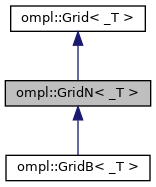Representation of a grid where cells keep track of how many neighbors they have.
More...
|
|
using | BaseCell = typename Grid< _T >::Cell |
| | Datatype for cell in base class.
|
| |
|
using | BaseCellArray = typename Grid< _T >::CellArray |
| | Datatype for array of cells in base class.
|
| |
|
using | Coord = typename Grid< _T >::Coord |
| | Datatype for cell coordinates.
|
| |
|
using | CellArray = std::vector< Cell * > |
| | The datatype for arrays of cells.
|
| |
|
using | Coord = Eigen::VectorXi |
| | Definition of a coordinate within this grid.
|
| |
|
using | CellArray = std::vector< Cell * > |
| | The datatype for arrays of cells.
|
| |
|
using | iterator = typename CoordHash::const_iterator |
| | We only allow const iterators.
|
| |
|
|
| GridN (unsigned int dimension) |
| | The constructor takes the dimension of the grid as argument.
|
| |
| void | setDimension (unsigned int dimension) |
| |
| void | setBounds (const Coord &low, const Coord &up) |
| |
| void | setInteriorCellNeighborLimit (unsigned int count) |
| |
|
Cell * | getCell (const Coord &coord) const |
| | Get the cell at a specified coordinate.
|
| |
|
void | neighbors (const Cell *cell, CellArray &list) const |
| | Get the list of neighbors for a given cell.
|
| |
|
void | neighbors (const Coord &coord, CellArray &list) const |
| | Get the list of neighbors for a given coordinate.
|
| |
|
void | neighbors (Coord &coord, CellArray &list) const |
| | Get the list of neighbors for a given coordinate.
|
| |
| BaseCell * | createCell (const Coord &coord, BaseCellArray *nbh=nullptr) override |
| |
| bool | remove (BaseCell *cell) override |
| |
|
void | getCells (CellArray &cells) const |
| | Get the set of instantiated cells in the grid.
|
| |
|
| Grid (unsigned int dimension) |
| | The constructor takes the dimension of the grid as argument.
|
| |
|
virtual | ~Grid () |
| | Destructor.
|
| |
|
virtual void | clear () |
| | Clear all cells in the grid.
|
| |
|
unsigned int | getDimension () const |
| | Return the dimension of the grid.
|
| |
| void | setDimension (unsigned int dimension) |
| |
|
bool | has (const Coord &coord) const |
| | Check if a cell exists at the specified coordinate.
|
| |
|
Cell * | getCell (const Coord &coord) const |
| | Get the cell at a specified coordinate.
|
| |
|
void | neighbors (const Cell *cell, CellArray &list) const |
| | Get the list of neighbors for a given cell.
|
| |
|
void | neighbors (const Coord &coord, CellArray &list) const |
| | Get the list of neighbors for a given coordinate.
|
| |
|
void | neighbors (Coord &coord, CellArray &list) const |
| | Get the list of neighbors for a given coordinate.
|
| |
|
std::vector< std::vector< Cell * > > | components () const |
| | Get the connected components formed by the cells in this grid (based on neighboring relation)
|
| |
| virtual Cell * | createCell (const Coord &coord, CellArray *nbh=nullptr) |
| |
| virtual bool | remove (Cell *cell) |
| |
|
virtual void | add (Cell *cell) |
| | Add an instantiated cell to the grid.
|
| |
|
virtual void | destroyCell (Cell *cell) const |
| | Clear the memory occupied by a cell; do not call this function unless remove() was called first.
|
| |
|
void | getContent (std::vector< _T > &content) const |
| | Get the data stored in the cells we are aware of.
|
| |
|
void | getCoordinates (std::vector< Coord * > &coords) const |
| | Get the set of coordinates where there are cells.
|
| |
|
void | getCells (CellArray &cells) const |
| | Get the set of instantiated cells in the grid.
|
| |
|
void | printCoord (Coord &coord, std::ostream &out=std::cout) const |
| | Print the value of a coordinate to a stream.
|
| |
|
bool | empty () const |
| | Check if the grid is empty.
|
| |
|
unsigned int | size () const |
| | Check the size of the grid.
|
| |
|
virtual void | status (std::ostream &out=std::cout) const |
| | Print information about the data in this grid structure.
|
| |
|
iterator | begin () const |
| | Return the begin() iterator for the grid.
|
| |
|
iterator | end () const |
| | Return the end() iterator for the grid.
|
| |
template<typename _T>
class ompl::GridN< _T >
Representation of a grid where cells keep track of how many neighbors they have.
Definition at line 78 of file GridN.h.

 Public Types inherited from ompl::Grid< _T >
Public Types inherited from ompl::Grid< _T > Public Member Functions inherited from ompl::Grid< _T >
Public Member Functions inherited from ompl::Grid< _T > Protected Member Functions inherited from ompl::Grid< _T >
Protected Member Functions inherited from ompl::Grid< _T > Protected Attributes inherited from ompl::Grid< _T >
Protected Attributes inherited from ompl::Grid< _T > Protected Types inherited from ompl::Grid< _T >
Protected Types inherited from ompl::Grid< _T >